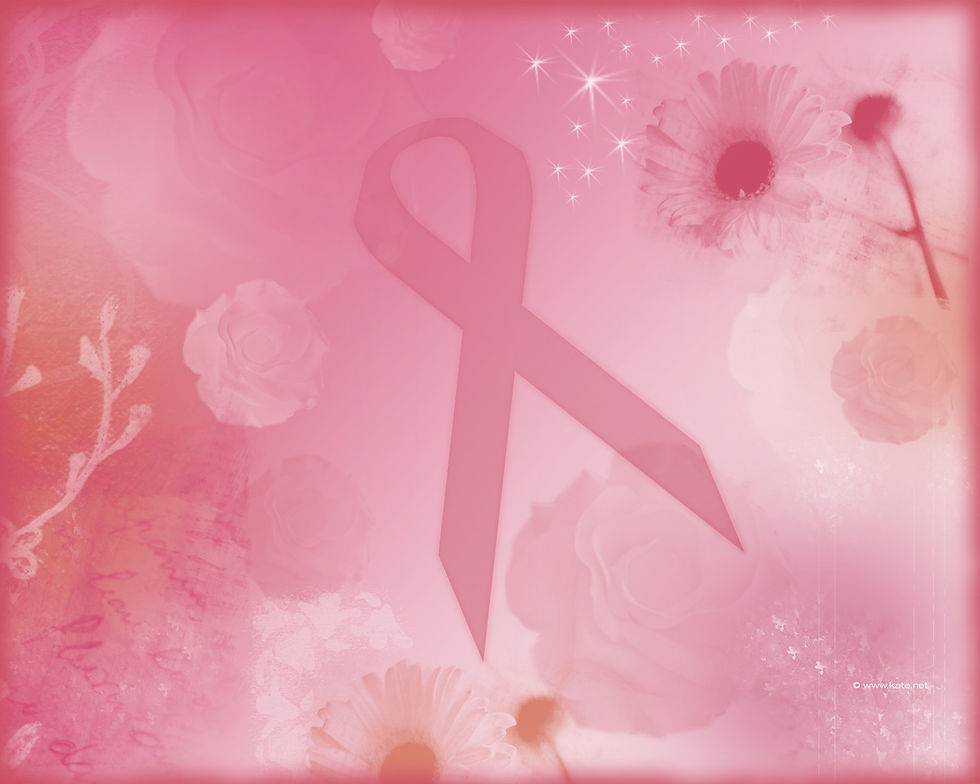Breast Cancer
- backtolife
- Aug 9, 2018
- 3 min read

According to the World Health Organization, breast cancer is the most common cancer among women worldwide, claiming the lives of hundreds of thousands of women each year and affecting countries at all levels of modernization. All people though, whether male or female, are born with some breast cells and tissue. Even though males do not develop milk-producing breasts, a man’s breast cells and tissue can still develop cancer. Even so, male breast cancer is very rare. Less than one percent of all breast cancer cases develop in men, and only one in a thousand men will ever be diagnosed with breast cancer.
Cancer grows when a cell’s DNA is damaged, but why or how that DNA becomes damaged is still unknown. It could be genetic or environmental, or in most cases, a combination of the two. But most patients will never know exactly what caused their cancer. However, there are certain established risk factors that are associated with breast cancer.
Gender: Breast cancer occurs nearly 100 times more often in women than in men.
Age: Two out of three women with invasive cancer are diagnosed after age 55.
Race: Breast cancer is diagnosed more often in Caucasian women than women of other races.
Family History and Genetic Factors: If your mother, sister, father or child has been diagnosed with breast or ovarian cancer, you have a higher risk of being diagnosed with breast cancer in the future. Your risk increases if your relative was diagnosed before the age of 50.
Personal Health History: If you have been diagnosed with breast cancer in one breast, you have an increased risk of being diagnosed with breast cancer in the other breast in the future.
Menstrual and Reproductive History: Early menstruation (before age 12), late menopause (after 55), having your first child at an older age, or never having given birth can also increase your risk for breast cancer.
Certain Genome Changes: Mutations in certain genes, such as BRCA1 and BRCA2, can increase your risk for breast cancer. This is determined through a genetic test, which you may consider taking if you have a family history of breast cancer. Individuals with these gene mutations can pass the gene mutation onto their children.
Dense Breast Tissue: Having dense breast tissue can increase your risk for breast cancer and make lumps harder to detect. Several states have passed laws requiring physicians to disclose to women if their mammogram indicates that they have dense breasts so that they are aware of this risk. Be sure to ask your physician if you have dense breasts and what the implications of having dense breasts are.
Lifestyle Recommendations:
• Perform an estrogen metabolism test, such as the Estronex Profile. • Avoid a sedentary lifestyle; incorporate regular exercise into lifestyle; get outdoors and into the sunshine. • Avoid toxic chemical exposure in the home; opt for safe cleaners; have plenty of air-cleaning plants in the home; use HEPA filters. • Use organic and safe cosmetics to avoid exposure to endocrine disrupting chemicals. References can be found on the Environmental Working Group’s “Skin Deep” database. • Maintain ideal weight and body composition; avoid abdominal fat. • Eliminate or avoid excess alcohol. • Do not allow sleep deprivation; use nutrition to help with chronic insomnia if necessary. • Pray/meditate/rest restoratively every day to improve the immune system. • Avoid dwelling on negative emotions and thoughts, holding grudges, and neglecting self-care; embrace gratitude. • Spend quality time with true friends.
Dietary Tips and Caveats:
• Choose organic, antibiotic and hormone-free dairy and animal products and organic produce. • Consume adequate amounts of antioxidants and flavonoids which can be obtained daily through 5-9 servings of vegetables/fruit. • Choose healthy fats and high quality whole protein sources; avoid ALL fried foods and partially hydrogenated fats. • Avoid sugar-laden foods and high fructose corn syrup. • Eat freshly ground flax seeds or chia seeds to incorporate more fiber into the diet. • Eat an abundance of cruciferous vegetables in order to supply beneficial isothiocyanates. • Use an abundance of herbs and spices such as turmeric, garlic, basil, and cloves.
How Chiropractic Care Can Help You During This Time:
Cancer and its treatments often cause stress on the musculoskeletal system. Some cancer patients experience peripheral neuropathy, aches and pains in the neck and/or back, muscle tension, headaches or difficulty walking. It may help to relieve pain and stiffness in the joints and muscles caused or intensified by surgery, chemotherapy or radiation therapy. Chiropractic care may help to reduce stress and increase mobility, flexibility, strength and function. A chiropractic adjustment may help alleviate a variety of the symptoms that you may experience during this time.






Comments